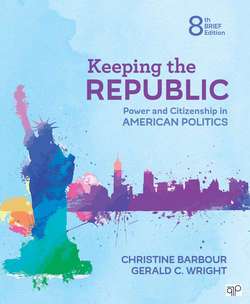Читать книгу Keeping the Republic - Christine Barbour - Страница 75
На сайте Литреса книга снята с продажи.
On keeping the republic
Оглавление“Be responsible, live out your responsibilities as a citizen, dedicate some amount of your time every day or every week to knowing what is going on in the world, be active in campaigns, and if nobody is worthy of your support, run yourself. . . . The whole notion of civil society [is] doing something as a volunteer, doing something, helping your fellow American, being involved with human beings. America only works as an organic society. . . . We’re the most stunningly voluntaristic society in the world. And so if voluntarism dries up, in some ways America dries up.”
Source: Newt Gingrich spoke with Christine Barbour on March 21, 2005.
The political elite in the new country started to grumble about popular tyranny. In a monarchy, one feared the unrestrained power of the king, but perhaps in a republican government, one had to fear the unrestrained power of the people. The final straw was Shays’s Rebellion. Massachusetts was a state whose legislature, dominated by wealthy and secure citizens, had not taken measures to aid the debt-ridden population. Beginning in the summer of 1786, mobs of musket-wielding farmers from western Massachusetts began marching on the Massachusetts courts and disrupting the trials of debtors in an attempt to prevent their land from being foreclosed (taken by those to whom the farmers owed money). The farmers demanded action by a state legislature they saw as biased toward the interests of the rich. Their actions against the state culminated in the January 1787 attack on the Springfield, Massachusetts, federal armory, which housed more than 450 tons of military supplies. Led by a former captain in the Continental Army, Daniel Shays, the mob, now an army of more than 1,500 farmers, stormed the armory. They were turned back, but only after a violent clash with the state militia, raised to counter the uprisings. Such mob action frightened and embarrassed the leaders of the United States, who of course also were the wealthier members of society. The rebellion seemed to foreshadow the failure of their grand experiment in self-governance and certainly challenged their story of what it was about. In the minds of the nation’s leaders, it underscored the importance of discovering what James Madison would call “a republican remedy for those diseases most incident to republican government.”19 In other words, they had to find a way to contain and limit the will of the people in a government that was to be based on that will. If the rules of government were not producing the “right” winners and losers, the rules would have to be changed before the elite lost control of their narrative and the power to change the rules.
popular tyranny the unrestrained power of the people
Shays’s Rebellion a grassroots uprising (1787) by armed Massachusetts farmers protesting foreclosures
In Your Own Words
Explain the competing narratives under the Articles of Confederation.
